So, You Think You Love Horses?
Some Reflections on the Nature of Horses and Man
Glossary of Equestrian Terms Words Beginning with M
A Cute Picture, but Not a Good Idea
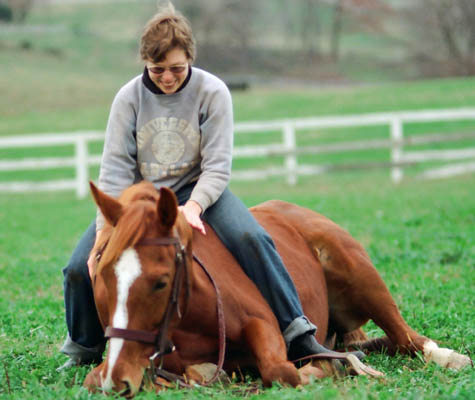
|
-
Madigan Foal Squeeze
[Veterinary Medicine] Madigan foal squeeze is a technique developed by Dr. John Madigan to treat newborn foals with Neonatal Maladjustment Syndrome (NMS). A gentle pressure is applied to the foal's chest using a rope, mimicking normal birth, which is believed to help reset the foal's neurological system. This is followed by it standing and nursing normally.
-
Mammalia
[Equine Taxonomy] Mammalia (mammals) is the taxonomic class name in the classification of animals, including fur-bearing animals that nurse their young. Both humans and horses are members of the class, as well as over 4000 other animals. Humans are fairly, but not entirely, unique within the class in that they have lost most but not all of their hair. This is believed to have been an adaptation for enhanced heat dissipation during hunting in a hot climate that may have been reinforced by additional mating selection.
-
Manège Movements (Schooling Movements or Figures
[Dressage] The manège movements are a series of schooling actions, practiced over and over until they are executed with precision. They include all the gaits and turns, as well as transitions and lateral movements. The French word manège used in the sense of a école d’équitation means riding schooling.
-
Manure Fork
[Horse Management] A manure fork is used to pick up horse manure to dispose of it. They come in a number of variations and I have several types in several places, including the horse trailer. I prefer ones with metal tines. Plastic ones will break if you are not careful. You want the times close enough that the manure does not fall through. Ones with blunt tines do not move through bedding very well.
-
Mare
[Horse Sex] A mare is a female horse that is older than 4 years. A younger female is called a filly.
-
Marks
[Dressage] A mark is a scoring point given to dressage competitors during a dressage test by the judges. Marks range from one to ten for each movement or transition. At the end of the test all the competitors marks are tallied, turned into a percentage and the rider with the highest percentage wins the competition. The rank order of the various riders marks establishes what is called their standing in the competition. Like all competitive sports there is a element of subjectivity in the awarding of marks by judges that competitors will complain about. I cannot see how it might be done is any more equitable fashion myself.
-
Martingale
[Horse Tack] A martingale is an optional series of leather pieces designed to attach from saddle girth band, the front of a horse and then to the reins and prevent the animal from tossing its head upwards. When a horse suddenly raises its head above a certain point they tend to come off the bit and the rider can thereby lose control or even in extreme cases be struck in the head by the horse when in a forward position in the saddle. Martingales are used on driving horses, English horses, Western horses, military and police horses among others. You can picture that a cavalryman would not want a horse tossing its head at the instant he was swinging a saber. However, Martingales do have some drawbacks. A horse taken into deep water while in a martingale may be unable to raise its head above water level and is at risk of drowning. Also a horse that trips or slips is less able to restore its balance before hitting the ground. All in all, I have never used a martingale.
-
Massage in Horses
[Complimentary Veterinary Medicine] Horses like humans benefit from massage techniques. Early mentions of massage are found in human medical texts from China and Egypt. In more recent times the use of massage in horses has become more common and practitioners can be found in most communities. Part of the attraction is that all pharmacological interventions carry some risk of drug toxicities, while massage has few if any risks.
-
Master of Fox Hounds
[Fox Chasing] The master is the senior position of a hunt's staff and the person responsible for conducting and supervising the hunt. The master's authority is considered absolute, but he is also functioning as a host of the event. In larger hunts various duty may be assigned to other paid assistants.
-
McClellan Saddle
McClellan Saddle Two Images
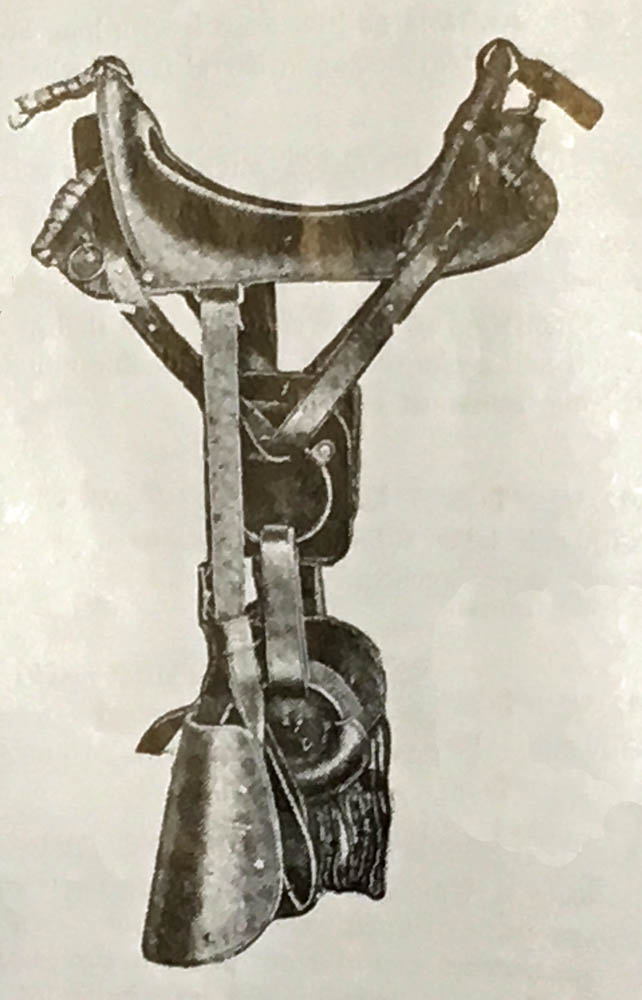
|
| 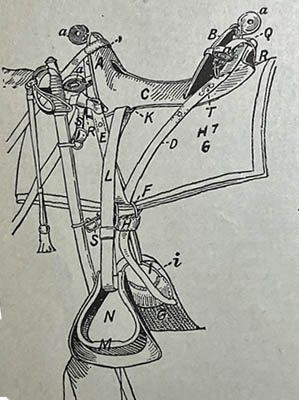
|
[Military] The McClellan saddle was developed by George B. McClellan after an inspection tour of European armies. It was adopted by the U.S. Army in 1859 and continued in use with modifications for 84 years.
-
Mecate Reins
Mecate Reins with Slobber Straps
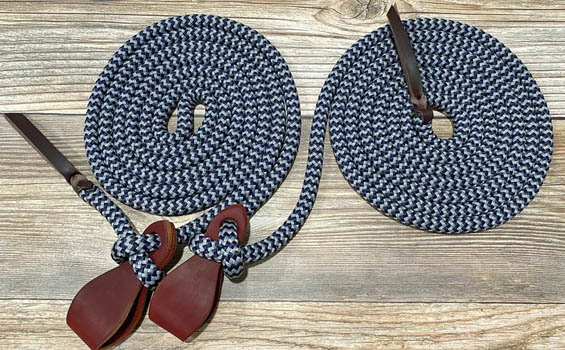
|
[Equine Equipage] Mecate reins are made from braided horse hair and synthetic rope. They are useful in initial training of a horse but no reason they could not be used for regular riding. They are usually used with a hackamore by western riders, but also can be connected to a bit using so called slobber straps. Mecate rein's rope it particularly long and can be used for all kinds of other functions. The excess robe is usually loop around the neck of the horse and the remaining rope is then tied around the saddle horn and used as a lead.
-
Melanoma in Horses
[Veterinary Medicine] Melanoma is the most common skin cancer occurring in horses. It is commonly found in older grey colored horses and unlike human melanoma it is fairly indolent. However eventually, it can spread to internal organs and can lead to the death of the animal. The genes that contribute to a gray coat color become overly expressed leading to growth of the tumors. A common place for the tumors to show up is under the tail and around the anus. At other locations they are firm, round lumps under the skin. Various treatments exist that can impede tumor growth. Among them is the drug Cimetidine, used to treat ulcers in humans but to retard Melanoma growth in horses. This is a good example how the same drug can have different effects in different species. Recent interest surrounds a vaccine against the tyrosinase gene, which is over-expressed in the tumors. .
-
Microchipping
[Equine Identification] In the past measures, such as branding or lower lip gum tattooing, were used for animal identification. A new method microchipping is coming to the fore. Many are familiar with this technic when used in domestic pets. It is relatively painless, easily done and inexpensive. A tiny microchip is injected into the left upper neck area by a veterinarian or technician. This can be read with a portable scanner. The scanner reads out a unique 15-digit International Organization of Standardization (ISO) number assigned to the animal. Many registries and and events now require microchipping as part of the registering process.
-
Milkweed (Asclepias species)
[Toxic Plant to horses] Milkweed is a native perennial herb with milky sap, resembling milk. It produces a host of toxins, including galitoxin, cardenolide toxicants and neurotoxins. Fortunately, milkweed is unpalatable and horses avoid eating it under usual conditions. However, if they are in an overgrazed area and hungry they might ingest it. I often discover milkweed growing in my fence lines and remove the plants. There are those who encourage planting of milkweeds for the benefit of Monarch butterflies, whose eggs are laid on milkweed plants. That should be no problem as long as they are far away from grazing animals.
-
Mill
[Vaulting] The mill is a vaulting compulsory competition move in which the rider turns all the way around on the moving horse's body in phases
-
Missouri Fox Trotter
[Horse Breed] .The Missouri Fox Trotter is a mid-sized, gaited breed that originated in the state of Missouri and were used for trail riding and ranch work. Its characteristic special natural gait is an ambling gait, known as the "fox trot.", This is a four-beat diagonal gait in which the front foot of the diagonal pair lands before the hind, eliminating the moment of suspension and increasing smoothness.
-
Mohair
[Equestrian Equipage] Mohair is soft yarn made from the hair of Angora goats. It is used to make horse tack items such as cinches, breast collars, reins, and mecates. Mohair has the advantages of being a durable, strong, elastic, breathable and moisture-wicking. material. However, it has the disadvantage that it is not as easy to clean as other materials.
-
Monkey Drill
[Military Equitation or Vaulting] A monkey drill was a riding exercise practiced at the U.S. Military Academy at West Point that required a cadet to mount and dismount a horse at a full gallop. Needless, to say injuries were not infrequent and among those effected was Dwight Eisenhower, who exacerbated a prior football knee injury doing this. The last West Point class receiving riding instruction was that of January 1943. This ability also was practiced by Cossacks, well developed in Native American horsemen and also by some doing vaulting today.
-
Moon Blindness (Periodic Ophthalmia or Recurrent Iridocyclitis)
[Veterinary Medicine] Moon blindness is serious, recurring inflammatory of the eyes that can result in total loss of sight over time. The name originated out of a false belief among horsemen that the onset followed the moon's phases. Signs of inflammation appears in either one or both eyes suddenly and then remit in a few days. The horse is sensitive to light, has a closed eye lids, constricted pupils, conjunctivitis and lacrimation. Riboflavin may have preventative value, but is not helpful in treatment. Certain species of bacteria may also play a role and can be treated with antibiotics. Autoimmune etiologies are suspect and can be treated by steroids. I should point out that this condition may represent several different diseases with different causes, all presenting with the identical symptoms of moon blindness. In addition, there are several common and less serious conditions that present with some of the symptoms of moon blindness. There is no substitution for a prompt veterinary consultation if this condition is suspect.
-
Morgan Horses
Morgan Horse
Courtesy of Wikipedia by Anthony Domire Jr.
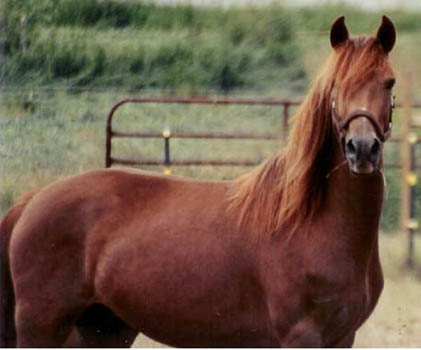
|
[Horse Breed] The Morgan breed was established by a talented American horse breeder, Justin Morgan (1747-1798) from a foundation sire, also renamed as Justin Morgan, who had a mixed Thoroughbred background. Morgans are relatively small horses with great dispositions, strength, stamina and relatively good speed. Morgans were employed as coach horses, harness racers, pleasure riding animals, and cavalry mounts and still have a loyal following among owners today.
-
Mounted Archery
[Sport and Military] Using arrows fired from a bow on horseback has been practiced since ancient times, both in hunting and warfare. An archer on foot has advantages of a stable platform, but a mounted archer is maneuverable at speed and useful in certain situations. In warfare a foot archer is subject to being overrun by cavalry, but on horseback he can flee to fight another day. The unexpected Parthian shot fired by a supposedly fleeing enemy claimed many a pursuer. Horse archery today is practiced as a sport and also by certain reenactors.
-
Mounted Games
[Equestrian Sport] Mounted games are a fast-paced team competition in which rider an various relay obstacle races, such as bending poles, stepping stones and a stacking races. The object is to have a good time and develop the rider's athletic ability, agility, precision
and general horsemanship.
-
Mounted Shooting (Cowboy Mounted Shooting or Western Mounted Shooting )
[Equestrian Sport] Mounted shooting is a competitive sport in which a rider fires blank cartilages in an attempt to break a target balloon while riding a course at a canter. Various firearms are used including pistols and long arms.
-
Mounting Block
A Simple Portable Mounting Block

|
[Equestrian Equipage] A mounting block is a fixed or portable structure designed.to elevate the rider closer to the saddle and assist in mounting an animal, often with steps and resembling a ladder or stairs. .
-
Mouthy
[Equine Behavior] A mouthy horse frequently nibbles or grabs objects with its mouth. This behavior is common in young horses and can include lip smacking and chewing on objects. If a horse tends toward mouthiness its best to keep things out of their reach. It can be very hard to get grass stains out of a white tee shirt or a jacket that you have striped off on a hot day of work around your horse. Sometimes mouthiness is extended to mouthing at a bit, but that is best considered in its own right rather than just simple mouthiness.
-
Multi-Directional Impact Protection System (MIPS)
[Riding Helmet Safety] Multi-Directional Impact Protection System is a helmet safety technology built into some of the newer riding helmets that reduces rotational forces on the brain during impacts. Its goal is to reduce the possibility of concussions after falling off a horse. Studies suggest that Mips reduced the overall injury risk by lowering the risk rotational movement of the brain in the skull, it did not decrease the linear movement risk.
-
Mustang
[Horse Type] The name Mustang is applied to the feral horse (often called wild horses) of the American west. These animals are descendants of domesticated horses imported by the Spanish that escaped captivity and established herds. Their blood lines have been supplemented by other stock that escaped and even by military stallions intentionally released by the U.S. Army to an effort to upgrade the size of the horses into ones that were larger and might have military use. As a result of this any individual mustang might vary in appearance but the type horse is often dun and relatively smaller, both characteristics of the original wild horses that were domesticated in ancient times. The Bureau of Land Management has been trying to manage the herds, which have been increasing in population and completing with grazing of cattle by ranchers. Public pressure has been against euthanizing the animals and large numbers are up for adoption. A person experienced in training can turn many of them into first class riding horses but I would suggest an inexperience person should not try this. I do feel sympathy for the horses, many of whom are confined to what amounts to feed lots.
Muzzle
[Equine Anatomy] A horse's muzzle is the soft part of the face between the nostrils and upper lip.
-
Muzzle (Grazing Muzzle)
A Horse Wearing a Muzzle

|
[Equine equipage] A muzzle is a bucket shaped device that the horse wears over his mouth to restrict over-consumption of pasture grasses and reduce risk of developing laminitis. Small horses and ponies are particularly at risk in the spring.
-
Myostatin Gene (MSTN)
[Genetics] The myostatin gene is a gene acknowledged to be a factor contributing to the speed of a racehorse. It increases muscle mass, impacting speed and stamina by inhibiting other genes that cause muscle growth to stop. Not only skeletal muscles are effected but also the muscle mass of the heart. No doubt that is why I need to feed my Thoroughbred twice as much as horses that are easy keepers. Best situation is a heterozygous combination of the T and C alleles at the myostatin gene locus. The C allele mutation has been traced to a British mare from 300 years ago. This combination was present in Nearcitic, the sire of Northern Dancer, ancestors of my gray and many of the other champion racehorses .
Glossary of Equestrian Terms: Main Alphabetical Listing
Links to Other Sites with Equestrian Interests
Back to Introduction







